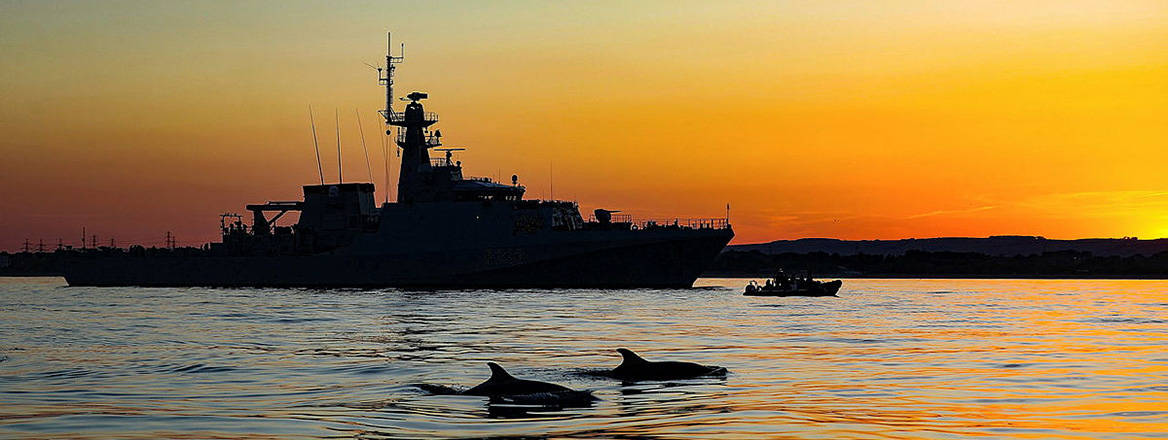Greening Defence: Prioritising Climate Change for a Sustainable Future
Defence will need greater internal collaboration across the single services if they are to successfully remove the stigma surrounding climate change mitigation and prepare to operate within a transformed environment.
There appears to be an unspoken perception within Defence that climate change is an imposition, one which does not fit easily with the conduct of warfare, and which only serves as an inconvenient constraint. What is more, our adversaries appear immune to environmental responsibilities, free to operate as they wish. However, the distance between national and climate security is closer than ever before; pressure is mounting on armed forces to play their part in mitigating its effects.
The threats of our modern world, made worse by rising seas, extreme weather, and creeping desertification, will almost certainly lead to more conflict
Lt Gen Richard Nugee CBE, author of Climate Change and Sustainability Strategic Approach
It is no longer merely a legal obligation to meet net zero carbon emissions by 2050, nor a moral obligation to do the right thing, but increasingly an operational imperative to reduce carbon emissions and become more sustainable. Failing to do so will risk altering the future operational environment to such a degree that our militaries will be unable to protect, operate and fight. In return, future green technologies will offer significant operational advantages such as reduced thermal and noise signature, improved platform performance and reduced logistical chains. As Chief of Defence Logistics and Support, Lt Gen Richard Wardlaw OBE rightly noted at the 2021 Defence Sustainability Conference ‘the greening ambition is a generational opportunity to deliver a step change in fighting power’.
But what is sustainability, and why is climate change so critical to defence? The 1987 Brundtland Commission report for the UN defined sustainability as ‘meeting the needs of the present without compromising the ability of future generations to meet their own needs’. So, while this is not a new concept, it is one that has gathered increasing attention due to more readily available data and subsequent media focus. In the short term, Defence has opted to focus on the reduction of carbon emissions to mitigate the impact of climate change. In the longer term, there will also be a need to focus on how the military sustains itself, namely through the provision of food, water, energy and fuel – factors which will have a significant impact on the way that military logistical supply chains function, particularly within the context of disaster relief operations.
But just how big is the challenge? The Ministry of Defence (MoD) holds the unenviable position of being the UK government department with the highest reported greenhouse gas emissions. Disturbingly, emissions may be even greater than stated, given concerns over inaccuracy of reporting and exemptions for ‘defence needs’. This will not be a simple or quick problem to solve. A cultural change of mindset will be required to prioritise the environment and view change as an opportunity rather than an imposition. This will require senior leadership buy-in to champion the cause. Other factors for success are likely to depend on appropriate resourcing by Defence and a more flexible, reactive approach to procurement. Defence claims to be a ‘fast-follower’ of the industry approach to technology, but it will need to reframe the relationship with industry through an adjusted, sustainable procurement framework to facilitate changes such as end-to-end costing which considers the full lifecycle of any technology implemented along with the social value of the project, and the implementation of flexible contracts which provide an ability to upscale existing projects in response to established needs, but which also feature trigger points that would allow for the termination of poorly performing projects or programmes. This will only be possible if Defence is able to fully quantify its needs, particularly within the estate, and if it is willing to create a structure which incentivises while concurrently holding the chain of command to account (both carrot and stick).
What is the Military Currently Doing About It?
Defence’s opening gambit to tackle this thorny issue is outlined in the MoD’s Climate Change and Sustainability Strategic Approach (CCSSA) published in March 2021. While neither strategy nor policy, the CCSSA describes the complexity of the challenge faced, the types of responses required and the timeframe for completion. It is hoped that this approach will facilitate the reduction of carbon emissions, in turn ensuring Defence adheres to government-defined net zero targets.
While the CCSSA provides a much-needed framework to illustrate how change might happen in an area that was rarely discussed within the military only 12 months ago, each single service must commit to the three ‘epochs’ of work required. At present, it seems like the efforts deployed by each service to ‘go green’ are being conducted in isolation, and at times competing with the other services to be seen as taking the most pioneering approach. Given that the mission to improve capabilities and reduce carbon outputs is a shared goal, a more inclusive approach is required to break down isolated silos, adopt a co-ordinated response and share examples of best practice to facilitate improved results.
A cultural change of mindset will be required to prioritise the environment and view change as an opportunity rather than an imposition
Benefitting from senior leadership buy-in, the Chief of the Air Staff has set the RAF the ambitious target of net zero by 2040. To achieve this will require significant advances in the sustainable production of synthetic jet fuel, given that aviation fuel for the UK armed forces accounts for two-thirds of all fuel use by the MoD. The RAF may therefore be reliant on carbon offsetting or sequestration in the short term to achieve targets.
As the largest owner of the military estate, the Army perhaps possesses the greatest opportunity for carbon emissions reduction, and has made some steps with renewable energy such as Project Prometheus. The decision to electrify a large land fleet and the precise timeframe for the transformation will be critical to success. It is hoped that by being a ‘fast-follower’ of industry when it comes to technology, the Army will be flexible enough to balance the upfront costs of converting early – when technology is still relatively expensive – versus carrying out pricey retrofits of older platforms later on. This approach will require a heavy reliance on industry and may prove somewhat naive without financial commitment from the Army.
Finally, the Royal Navy has quietly begun incorporating green technologies on its newest warships, including systems to reduce nitrogen oxide emissions by up to 97% on HMS Tamar and HMS Spey. A new Market Exploration scheme will seek to identify powertrain solutions to retrofit to current vessels, and is forecast to reduce emissions by up to 40%.
There are merits to each of the projects described which will inevitably shape the response of each force in the short term. However, Defence now needs to adopt a formal policy which is championed from the top down and has long-term goals in mind.
The next Commentary in this series will focus on the 2021 Climate Change and Sustainability Strategic Approach and how effectively it outlines Defence’s response to climate change.
The views expressed in this Commentary are the author’s, and do not represent those of RUSI or any other institution.
Have an idea for a Commentary you’d like to write for us? Send a short pitch to commentaries@rusi.org and we’ll get back to you if it fits into our research interests. Full guidelines for contributors can be found here.
WRITTEN BY
Dr Sarah Ashbridge
Affiliate Expert, Military Sciences
Lieutenant Colonel Alistair Beard
Former Army Visiting Fellow



